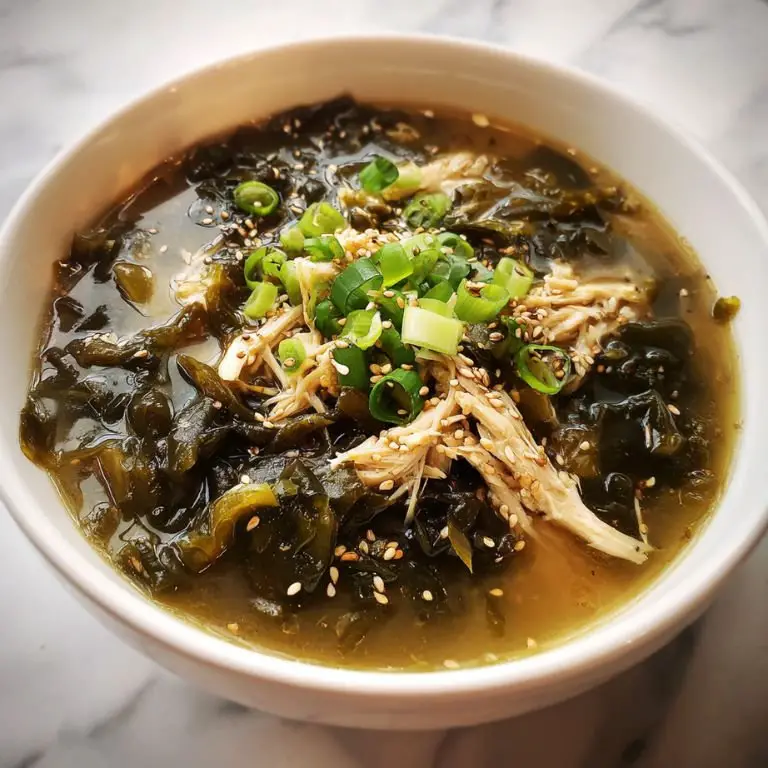If there’s one dish that holds a sacred place in Korean postpartum care, it’s miyeok-guk, or Korean seaweed soup. This recipe for miyeok-guk with chicken and ginger offers a deeply nourishing twist on the traditional version by incorporating the warming properties of fresh ginger and the gentle protein of chicken. Often served to new mothers for its healing and replenishing benefits, this version also makes a comforting bowl for anyone looking to feel grounded and restored.
Let’s dive into how to make this soothing seaweed soup Korean recipe at home, with plenty of cultural and nutritional insight.
Nourishing Miyeok-Guk with Chicken and Ginger
Prep Time 10 minutes mins
Cook Time 25 minutes mins
Total Time 35 minutes mins
Course Main Course, Soup
Cuisine Korean
Medium to large soup pot A heavy-bottomed pot is ideal for maintaining a steady simmer. A Dutch oven works beautifully.
Mixing bowl For soaking the dried seaweed.
Cutting board and knife For prepping the ginger, chicken, and aromatics.
Soup ladle Makes serving easier and ensures you get seaweed, chicken, and broth in every bowl.
Seaweed & Soup Base
- 1 oz about 30g dried miyeok (Korean wakame seaweed)
- 1 tablespoon toasted sesame oil
- 1 teaspoon neutral oil like canola or sunflower oil
- 2 teaspoons soy sauce Korean guk-ganjang if available
- 6 cups water or low-sodium chicken broth
Protein & Flavorings
- 1 boneless skinless chicken thigh (or chicken breast), thinly sliced or shredded
- 1 tablespoon ginger julienned or finely chopped
- 2 garlic cloves minced
- Salt to taste
Optional: dash of fish sauce or Korean soup soy sauce for depth
Garnish (Optional)
- Sliced scallions
- Toasted sesame seeds
- Few drops of sesame oil before serving
Soak the Seaweed
Place the dried miyeok in a large bowl of cold water and let it soak for 10–15 minutes. It will expand significantly—up to 10 times its original volume.
Once rehydrated, drain it, rinse under cold water, and squeeze out excess liquid. Chop into bite-sized pieces (roughly 2-inch sections). Set aside.
Sauté the Aromatics
In your soup pot, heat the sesame oil and neutral oil over medium heat. Add the minced garlic and julienned ginger. Sauté for about 1 minute until fragrant, but not browned.
Add the Chicken
Toss in the sliced or shredded chicken and cook until just no longer pink, about 2–3 minutes. This step infuses the chicken with flavor and gives the soup more depth.
Stir in the Seaweed
Add the chopped miyeok and continue stirring for 2–3 minutes. The seaweed will absorb the aromatic oils and deepen in flavor.
Add Liquid and Simmer
Pour in 6 cups of water or chicken broth. Stir in the soy sauce and bring the soup to a gentle boil. Once boiling, reduce the heat to low and let it simmer for 15–20 minutes. Skim off any foam or impurities that rise to the surface.
Taste and adjust the seasoning with salt or a dash of fish sauce. For a slightly richer taste, a splash of Korean soup soy sauce (guk-ganjang) goes a long way.
Serve and Garnish
Ladle into bowls and top with sliced scallions and a sprinkle of toasted sesame seeds. Drizzle a few drops of sesame oil for added aroma. Serve hot and enjoy the deeply comforting flavors.
What to Pair with Miyeok-Guk
Though miyeok-guk can stand on its own as a restorative soup, it shines even more when paired with traditional Korean dishes:
- Steamed white rice – The classic companion. Its neutral flavor balances the savory richness of the soup.
- Korean cucumber kimchi – Crunchy and refreshing, this light kimchi adds zing. If you want to make it yourself, check out a simple cucumber kimchi recipe Korean style using gochugaru, garlic, and vinegar.
- Sautéed Korean vegetables – Banchan like spinach (sigeumchi namul) or bean sprouts (kongnamul) add texture and additional nutrients.
- Korean tofu soup – A mild version like sundubu jjigae offers soft tofu and broth to complement the miyeok-guk.
- Korean cold noodles recipe – On warmer days, serve miyeok-guk with naengmyeon or bibim-guksu to provide a hot-cold contrast.
- Simple omelet (gyeran mari) – A rolled Korean-style egg omelet is a gentle, protein-packed side perfect for postpartum meals.
FAQs
1. Can I use chicken breast instead of thigh?
Yes, you can. Chicken thigh offers a richer, more tender texture and flavor, but chicken breast works well if you prefer a leaner option. Just make sure not to overcook it, as it can dry out quickly.
2. Is this seaweed soup recipe suitable for vegetarians?
While this version includes chicken, you can easily adapt it. Use tofu instead of chicken, vegetable broth instead of chicken broth, and skip fish sauce. You’ll still get a deeply satisfying korean soup aesthetic.
3. What type of seaweed should I use?
Look for dried miyeok (wakame) specifically labeled for korean seaweed soup. Avoid nori or other sushi-grade seaweeds, as they don’t rehydrate the same way.
4. Can I freeze miyeok-guk?
Yes, it freezes well. Store in airtight containers in single portions. Reheat gently on the stove, adding a splash of water or broth to loosen it up.
5. Is this dish eaten only postpartum?
While it’s traditionally served to new mothers, miyeok-guk is commonly enjoyed by everyone in Korea—especially on birthdays. It’s considered a reminder of motherhood and care. You can enjoy this seaweed soup Korean recipe anytime you need a gentle, healing meal.
